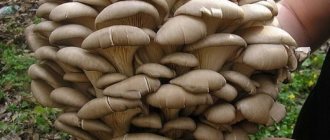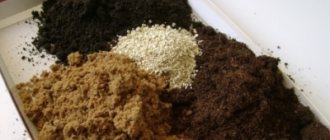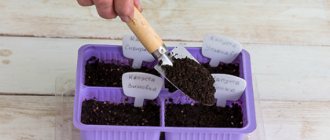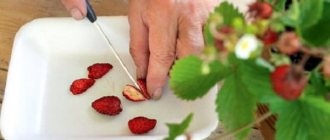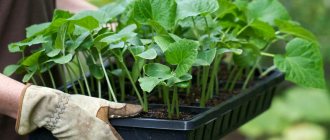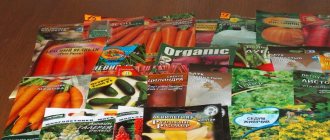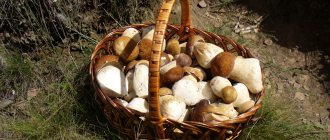Preparing the land for seedlings is an important stage in growing plants. The health of young plantings, their ability to actively grow and resistance to adverse factors depends on the quality of the soil. All this will ultimately affect the quality of the crop. Therefore, gardeners try to prepare the soil mixture themselves. Let's figure out how to do it right.
General requirements
Land preparation
Which specific components should be in the soil depends on what crop it is intended for. Regardless of this, the following requirements must be met:
- fertility
The presence of all nutrients in the soil will allow the seedlings to grow and develop normally and fully.
- balance of constituent elements
The composition depends on the culture it is intended for.
The content of organic, macro- and microelements should be in such quantities as to fully satisfy the needs of the young sprout.
- lightness and friability of structure
Good air exchange in the soil is very important for the small root system of sprouts.
- moisture capacity
The prepared soil should have good absorption and retention of moisture.
- neutrality of reaction
The acidity level limits should not exceed 6.5-7.0.
- the absence of everything unnecessary (pathogenic microbes, weed seeds, fungal spores and other debris), which can lead to the death of a young sprout
- absolute purity
Finding impurities of heavy metals, hazardous industrial waste, etc. indicates poor quality of the prepared mixture. This will affect the seedlings, their development and health.
What is garden soil?
Garden soil is intended to be applied directly to garden beds as a valuable fertilizer. It is usually created from a mixture of compost, fertilizer, topsoil and other materials.
If you want to kill seedlings, try sowing the seeds into soil from your garden. The fact is that the garden soil is too dense and heavy; it will not allow tender seedlings to break through and will suffocate their root system. Additionally, garden soil is not as loose and contains large chunks that are not ideal for seeds.
Main components
Quality implies the presence of organic and inorganic components
A soil mixture is considered to be of good quality if it consists of organic and inorganic ingredients.
Organics include:
- turf land
The preparation must be done in advance. To do this, the turf is cut into square layers and laid in even rows.
- soil from the garden
Taken directly from the garden plot.
- leaf soil
Sod land
Fertilizer is prepared from fallen leaves.
- humus
- compost
- lowland peat
- sphagnum moss
- sunflower husk
- crushed egg shells
- wood ash
Perlite
Inorganic is:
- river sand
- perlite
It is a clean, environmentally friendly raw material. Has a neutral acidity level. Does not contain heavy metals.
- vermiculite
Refers to environmentally friendly materials. It has porosity. The composition contains potassium, calcium, and magnesium in small quantities.
- hydrogel
Refers to polymers. It accepts and retains moisture well.
- expanded clay
- crushed polystyrene foam
Reviews from the forum
– I believe that the best soil for cucumbers is soil from the garden and sawdust. Of course, they are stale. It works well and the seedlings grow without problems. I've never tried it with sand.
Galina, Tyumen
– I only take my own land, from my summer cottage, for seedlings. I prepare the soil for seedlings in advance. And then somehow I didn’t take care of it on time, I had to buy it at the store. And either I was unlucky, or it was just karma - the seedlings died. There was bad soil. Then I had to buy seedlings from private owners. I don't take any more risks.
Maxim Vladimirovich, Taganrog
– I also mix the soil myself. I put humus in the ground, 2 to 1, and, of course, more ash. And I cook everything in the fall. I put it in bags and store it in the barn in winter. It will freeze well, why not disinfection? And then I bring the bags of earth into the warmth. When the land warms up, I sow.
Elena Vasilievna, Perm
– An interesting device that measures acidity! I should buy it.
Vadim, Kirovgrad
– Is it possible to use flower soil for tomato seedlings?
Irina, Zarechny
– Irina, it’s better not to take risks! What acidity is indicated on the package? Look first, there are different types of peat soil that are sold. Better buy a special one.
Maxim Vladimirovich, Taganrog
- Thanks for the info. I learned a lot of interesting things.
Victoria, Runga
The gardeners’ efforts to prepare the soil mixture for seedlings will pay off in the summer, when a bountiful harvest appears. However, plants will only generously thank gardeners when all the rules of care are followed. One of the main requirements is correctly selected soil components for growing seedlings, taking into account the characteristic characteristics of the crops.
Health to you and your loved ones! Natalya Belokopytova.
Undesirable components
Clay is a harmful indicator
The presence of clay and components in the soil that actively decompose is a harmful indicator.
Fresh manure, unrotted leaves, and tea leaves begin to rot when they get into the soil. During this process, heat is released in the substrate and the proportion of nitrogen decreases, which harms the still immature seedlings.
When the soil temperature rises above 30 0C, the roots of young plants die.
Clay makes the soil denser and heavier. This affects its air exchange and moisture capacity. This can lead to disease and possible death of the sprouts.
Characteristics of inorganic components
Components of inorganic origin are presented:
- Quartz sand. It must be river or quarry and not contain impurities. Sand helps loosen and improve the soil structure;
- Perlite. To prepare soil for seedlings with your own hands, use perlite. This mineral of volcanic origin is a good leavening agent;
- Expanded vermiculite. The lamellar structure of the mineral helps accumulate and retain moisture and improves aeration.
- Expanded clay. It is a natural drainage that helps improve the structure and aeration of the soil mixture;
- Hydrogel. Since this compound of synthetic origin is capable of absorbing moisture well, it can retain soil water, gradually releasing it.
In addition to the above components, it is necessary to add mineral fertilizers to the soil substrate - ammonium nitrate, potassium sulfate and chloride, and a nitrogen-phosphorus agent. The dosage of fertilizers is calculated in accordance with the needs of the crop that is going to be grown in the prepared land.
The ingredients of this soil must not contain admixtures of other substances. In addition, before mixing, they must be sifted. It is taken into account that fractions that are too small after irrigation become compacted and aeration is disrupted. Their “souring” may also be observed.
When preparing land for seedlings, all of the above components are necessary. However, some substances that get into the soil can significantly reduce the quality of the prepared substrate.
These include:
- clay, it makes the soil mixture heavier and makes it dense, reducing aeration;
- fresh manure, when decomposed it significantly increases the soil temperature, causing damage to the root system of seedlings;
- tea leaves, coffee grounds and some other components, they can also negatively affect the development of plants;
- sea sand and the salt it contains can disrupt the level of salinity in the soil mixture required by the plant.
In order to consider the preparation of soil mixtures for various crops, it is necessary to establish the acidity of the soil on the site and its structure.
Basic rules for DIY cooking
The composition should include only useful impurities, elements and feeding components
Soil for seedlings should not only not contain harmful impurities and elements, but also have a feeding component. To increase the fertility of the land, peat and humus are used.
Choosing a meeting place
Dernina
To prepare the soil on which the seeds of vegetables and flower crops will germinate, soil collected from a forest area can be used. It should form the main part. Certain areas are selected for digging, the basis of which is foliage and turf. This composition will allow you to obtain good and strong seedlings.
When choosing soil, pay special attention to the trees under which you are digging. They should not have dried branches, trunks, or damage from any diseases. The land under oak and willow has great fertility. These and other rocks do not release acid into the soil in large quantities.
The soil from the garden can also be used as a basis. But its use will require compliance with certain rules. This is necessary for the safety of the sprouts, from any risk that could destroy them after planting and germination.
Method for soil improvement
Required rules:
- disinfection of garden soil
- compliance with crop rotation
The soil on which certain vegetable and fruit crops were grown is not suitable for reuse.
Compound
Sawdust will not allow excess moisture to accumulate
To obtain a high-quality result, after the crops have matured, the mixture in which the seeds will be planted must be mixed and meet all standards. The composition of the collected soil is of 2 types:
- organic
- inorganic
If organic matter is not used to prepare soil for seedlings in order to increase its fertility, the following components can be used as a fertilizing component:
- recycled peat
- stove ash - this will enrich the soil with microelements and reduce the high level of soil acidity
- a mass of humus - suitable only for those plants that suffer from diseases leading to black stems
- twisted moss
- sawdust of different woods - will not allow excess moisture to accumulate
Humus
The organic structure of the listed components can quickly rot. It will saturate the soil with the necessary elements, fertilize it, which will enable the seeds to germinate better.
Elements of inorganic nature are also added:
- agroperlite
Controls the level of moisture in the soil.
- expanded clay
- sand
Improves soil air exchange, which will allow the small root system of seedlings to breathe well.
Cooking technology
Storage in bags
Features of preparing really good soil for seedlings are:
- the season when the land is harvested
The most favorable period of the year for preparing, collecting, and mixing all components is autumn. This will give time for all the collected components to ripen, mix, and form soil with good fertility.
- rules for preserving the prepared mixture
For storage it is necessary to use closed containers. Suitable for this:
- plastic buckets
- plastic bags
- large plastic containers
Under such conditions, substances will interact better with each other.
Do not forget that clay is not present in the mixture for seedlings.
How to prepare soil for seedlings - composition and proportions
At the initial stage of plant development, it can easily do without soil, since the seed germinates, produces seven-lobed leaves, and all this is due to the energy and nutrition from the seed itself. But in the future, for the full development of seedlings, there is no way to do without high-quality soil. Growing seedlings require more nutrients. And when there are a lot of seedlings, a lot of soil mixture will be required. Just one plant, for example a tomato, will require at least 1 liter of soil. And if you buy it, it will be quite expensive for your wallet.
Of course, soil for future seedlings can, and even should, be prepared in the fall, when the entire harvest has been harvested from the garden. But for those who did not do this on time, you can prepare it immediately before sowing the seeds.
When preparing the soil mixture yourself, there are no exact proportions and everything depends on our conditions and capabilities. Approximate composition and proportions may be as follows:
- compost – 25-50%,
- land - 20-25%,
- sand - 10-15%,
- peat – 30-35%.
Depending on the initial composition, there may be additions in the form of perlite or vermiculite, but we’ll talk about this a little later.
As you can see, the main component of soil for seedlings is compost. The remaining components may change or be present all at once. It is better to sift the compost, and you can use a plastic vegetable bin for this. When sifting the compost, all large fractions of earth (pebbles, sticks, etc.) remain in the box. Earthworms may remain in the sown soil, they are also of no use here, they need to be removed. After sifting, the soil becomes homogeneous, breathable and loose, which is what is needed, especially for small seeds.
Compost is best mixed with turf soil. To do this, remove the top layer of turf, and what is underneath needs to be sifted and added to the compost. Another very good turf soil is the one dug by moles. It is loose, does not contain roots or stones, and can be added to the soil mixture.
Is it possible to take soil from garden beds? There are both opponents and supporters of this method. Opponents argue that various pathogenic microflora can be introduced from the soil, while supporters argue that plants at the seedling stage do not need to be grown in sterile conditions and they must be close to the microflora in which they will later grow.
If you are afraid of introducing spider mites, then take the soil from under the cabbage. You can also add tobacco dust to the soil and mix it.
Sand makes loam or clay soil more breathable and loose; it also needs to be sifted. If sand is not available, it can be replaced with perlite or vermiculite.
If possible, add peat to the soil to increase moisture capacity; it is better to take high-moor peat. But keep in mind that high-moor peat is highly acidic. Then wood ash is added to deoxidize. Both peat and ash also need to be sifted.
All that remains is to thoroughly mix the entire soil mixture, and it is ready for planting seedlings in it.
And one more way to make good nutrient soil using bokashi. Bokashi is one of the world's most popular microbiological fertilizers for restoring natural soil fertility.
Step-by-step cooking instructions
The cooking process requires a careful and concentrated approach
The process of preparing the soil in which various crops will be grown requires great care and concentration. Only the quality of the prepared substrate will make it possible to grow strong seedlings and obtain an excellent harvest.
Preparing the soil according to all the rules before planting seedlings requires a large number of all the components included in it. Everything must be prepared in advance, long before the time for sowing the seeds.
As mentioned above, all components of the soil for seedlings should be collected in early autumn. In order for the result to be of high quality, you will need to follow the following instructions:
- All soil and other components are checked. They must be dried and distributed into separate containers
- A place is determined and a container is selected where all the prepared ingredients will be mixed. Any large containers are suitable for mixing
- The equipment needed for the procedure is being prepared.
- All ingredients are poured into a common container in equal parts. Then mixed
- The prepared soil mixture is poured into separate containers, bags, where it will subsequently be located
- Store prepared soil at low temperatures
Mineral components are not added at the soil preparation stage. They must be added to the soil when the seeds are planted.
Disinfection procedure
Compliance with the rules is the key to obtaining healthy, strong seedlings
Garden soil, leaf soil, turf, peat, sand, humus and other components of organic origin contain harmful bacteria. When added to the seedling substrate, they can introduce infection, which will harm the seeds and reduce the number of seedlings. To avoid such a situation, the soil must be disinfected. Neglecting this procedure is impossible, otherwise obtaining strong, healthy young, and later productive plants will remain only a dream.
There are several ways in which you can disinfect the substrate from pests:
- freezing
- steaming
- calcination
- pickling
One of the first three methods listed above is perfect for processing, but for a better result, the ideal option would be to complete the disinfection by etching.
It is necessary to freeze during the winter period. For other methods, the period of application begins when the substrate is prepared for sowing (January - February).
Freezing
Freezing the soil
The procedure is to place the bag with the substrate in a place where a constant temperature below 00C will be maintained. It is the most effective way.
If it is impossible to ensure such conditions, the following actions are performed:
- Towards the end of winter, the substrate is taken out into the cold and left for 7 days. It is necessary that the temperature is about -10...-150C
- After the allotted time has passed, the soil is brought into an insulated place and another 7 days. defrosted. If it was not possible to freeze all the weeds and possible insects the first time, they will wake up warm
- The freezing procedure is repeated 2-3 times
Steaming
Disinfection of soil for seedlings
The most favorable method of disinfection for the substrate. The procedure disinfects the soil and saturates it with moisture.
To carry out the work, you will need a sieve with a fine mesh (the earth should not spill out). The prepared soil is poured into a sieve and placed over a container in which water is boiling. With constant stirring, everything is steamed well for 8 minutes.
Calcination
Calcination in the oven
With this method, the soil is subjected to heat treatment. Required temperature +70…+900С. A lower temperature does not kill all microbes; a higher temperature disrupts the soil structure and leads to a decrease in fertility.
To carry out sterilization, an oven or microwave is used (for small volumes of processed material). The soil is scattered on the pallet in a thin layer. The layer should not exceed 5 cm. Then it is sprayed with water. The oven is preheated to the desired temperature. Warming up the substrate should take about half an hour.
Etching
Etching is more often used as an addition
This method is the simplest and is often used as a safety net when one of the above methods has already been carried out. It uses etchants that are diluted in water. The temperature of the solution (for example, potassium permanganate) depends on what procedure was carried out before. After disinfection using high temperatures, cold water is taken, after freezing - warm water (about +400C). Next, the substrate is poured into a sieve with small cells and completely spilled with the prepared liquid. It should be bright pink.
After sowing the seeds, the water for watering them must be settled or filtered. Tap water contains chlorine. It has an unfavorable effect on beneficial bacteria and their vital functions.
After the disinfection procedure, the soil must be placed in a container and spilled with a mineral solution. Each crop requires its own minerals. Next, the soil is moistened and transferred to prepared containers (cups, pots, etc.). Everything is ready for sowing.
Let's go to the forest
In the forest, under every tree there is leaf litter. Over time, it rots, forming a layer of humus, which is very valuable due to its nutritional value. If you remove the top foliage near a forest tree, then underneath it there is a fine-grained substrate.
If you find yourself in a coniferous forest, then coniferous humus will also form here from the falling needles. But this litter is too acidic, so it should not be used to prepare seedling mixture.
There is another tree from which you cannot take soil. This is a birch tree that oppresses the plants growing under it. The forest of birch trees is always light, with virtually no undergrowth. It is difficult for other trees and shrubs to grow, since birch produces substances that inhibit the development of other plants.
Which forest trees have the best soil for future seedlings?
- Hazel. The tree produces a lot of leaves that rot well;
- Linden. Go to the linden grove, as linden has good litter that forms high-quality humus;
- Maple. You can collect humus from under the maple tree, but only as a last resort. There are a lot of maple seeds in the soil and they will germinate in your container much earlier than the seedlings; they will then have to be removed.
When you bring home forest soil, be sure to sort it out, throw away the roots, small twigs, and leaves. Then sift and put into bags, placing them in a room where it will be cold for freezing and disinfection.
Various variations for individual species
Each type of culture has its own preferences
There are various options for soil suitable for the requirements of seedling material. A particular culture has its own conditions for this. For example, tomatoes prefer slightly alkaline soil. It should contain organic components, nitrogen, and potassium. For cabbage, the soil is mixed with lime and wood ash.
Below are the types of formulations that individual plants prefer.
Eggplant
Eggplant
1 Humus mass, peat mass, rotted sawdust - 2:1:0,5
2 Recipe:
- soil from the site - 1 bucket
- ash – ½ cup
- superphosphate – 1 tbsp. l
- carbamide or potassium sulfate – 1 tsp
Cabbage
Cabbage
- Turf, humus mass, peat mass - equal proportions
- Sod, ash, lime, sand – 20:5:1:1
- Peat mass, turf, a little sand – 12:4:1
cucumbers
cucumbers
1 Peat mass, humus mass, rotted sawdust – 2:2:1
For 10 liters of soil composition, it is necessary to add ash (1 tbsp.) and urea, superphosphate, potassium sulfate, 1 tsp each.
2 Sod, compost or humus mass – 1:1
Add ash (1 tbsp), potassium sulfate (10 g), superphosphate (20 g) to a 10-liter container of soil.
3 Peat mass, humus mass, sawdust, sand, mullein – 6:1:1:1:1
4 Sod, peat mass, humus mass, rotted sawdust – 1:1:1:1
Pepper
Pepper
- Sod, humus mass – 1:2
- Peat mass, humus mass – 2:2
- Humus mass, turf – 3:2
- Nutritious peat soil, turf – 2:1
- Peat mass, turf, humus mass, rotted sawdust – 4:2:1:1
Tomato
Tomatoes
1 Peat mass, turf, mullein – 16:4:1
For a 10-liter volume of the prepared composition, add river sand (3 l), ammonium nitrate (10 g), superphosphate (20-30 g), potassium chloride (10-15 g).
2 Peat mass, sawdust, mullein – 3:1:0.5
For a 10-liter volume of mixed ingredients, add river sand (3 l), ammonium nitrate (10 g), superphosphate (20-30 g), potassium chloride (10-15 g).
3 Humus mass, peat mass, turf, rotted sawdust – 1:1:1:1
Add ash (1.5 cups), superphosphate (3 tbsp), potassium sulfate (1 tbsp), urea (1 tsp) to a bucket of soil mixture.
Universal primer
Universal primer
Garden soil, humus or rotted compost, peat, sawdust or sand - 2:1:1:1
Additionally, fertilizers are added to the compositions. Their quantity is indicated per 10 liters of prepared soil:
- Cabbage:
- ammonium nitrate or urea – 15-20 g
- superphosphate – 20-25 g
- potassium sulfate – 10 g
- dolomite flour – 25 g
- Cucumbers:
- ammonium nitrate – 8-10 g
- superphosphate – 10-15 g
- potassium sulfate – 10 g
- dolomite flour – 10 g
- Tomatoes, peppers, eggplants:
- ammonium nitrate – 8-10 g;
- superphosphate – 80 g;
- potassium sulfate – 20-30 g;
Preparing soil in spring in a greenhouse
Even with a very strong desire, organic compounds in undiluted form are not used for sowing. These components are very rich in chemical elements. They will help the seedlings grow greenery; their appearance will be very attractive, which cannot be said about the root system. She will be weak and undeveloped. The survival rate of young plantings on the site will be poor.
The components of the mixture are not sifted through a fine strainer. Small soil fractions from watering will spread and ferment.
If it is impossible to prepare yourself
For the full development of seedlings, purchased options must be modified
Preparing soil is not affordable for everyone. There are ready-made, store-bought options from different manufacturers that you can buy without any problems . The only caveat is that they are not always prepared properly and may not be suitable for specific types of seedlings.
We are talking about universal mixtures. Its main component is peat, which has a high pH level and poor moisture permeability. Such conditions are unfavorable for the full growth of seedlings.
To obtain a composition in which the seedlings can fully develop, without stunting in growth, the purchased version is modified:
- The purchased universal mixture is mixed in equal parts with garden soil, which has previously been disinfected. In the absence of such, any available land is used. Suitable even from pots in which house flowers have disappeared
- To lower the pH, add chalk or dolomite flour at the rate of 1-2 tbsp. l. per bucket of soil
- To regulate moisture levels, hydrogel crystals can be used in very small quantities. This is very important because when moisture gets on the crystals, they become very large. The increase is 200-300 times
Coco soil
Coconut substrate in briquettes
Sometimes, no matter how hard you try to prepare the ground, the ideal result does not work out. Subsequently, the soil becomes acidic, cakes, becomes salty, and mold and pathogenic microflora appear on it.
Coconut substrate is now becoming popular. It belongs to environmentally friendly bio-soils. It is an excellent replacement for conventional earthen compounds. Recommended for growing vegetable seedlings (tomatoes, peppers, eggplants, etc.) and other garden and indoor plants.
Breed composition:
- coconut flakes – 30%
- coconut fiber – 70%
Sometimes peat and fertilizers are added to the composition. This information must be indicated on the packaging.
Coco soil
Main advantages:
- safety
The substrate does not contain fungal and other microorganisms; disinfection is not required for planting.
- pH level – 5.6-6.8
- high moisture capacity
Can hold up to 7 times its weight in moisture. The plant gradually receives moisture, which prevents the risk of flooding it.
- does not compact
By creating an ideal environment with good air permeability, the plant develops healthy roots, which makes it resistant to diseases. Productivity increases.
- excellent thermal conductivity
Spunbond cover
Young plants are protected from temperature changes.
- does not lose properties, has no expiration date
- can be used as:
- mulching material
- winter shelter in a flower garden
- makes heavy clay soil loose
- a component that increases the moisture capacity of sandy substrates
- filler containing rodents, snails, amphibians
- material for hydroponic growing of greens
If there are any residues left, they can be dried and used later if necessary. The properties are saved.
- can be used again
The already used substrate must be washed, disinfected and it is ready and can be used again.
- easily and completely recyclable
Coconut substrate
The coconut substrate is crushed and dug into the soil in the beds.
Using this composition is very simple. It is sold in dry briquettes.
To make soil for seedlings, fill the briquette with clean warm water (1:4) and leave for 10-20 minutes to absorb the liquid. Then everything is mixed. After this, the coconut material is ready.
When preparing a large volume of the composition, water is added in small portions, and the substrate is stirred several times. This will allow the mixture to be evenly saturated with water.
Unused remains must be dried for further storage. The wet mass will turn sour.
Knowing how to properly make a soil mixture, you can get to work with confidence. If all conditions are met, gardeners are guaranteed a good result.
VIDEO: Preparing the soil for seedlings yourself!
We prepare the soil for seedlings ourselves!
How to prepare soil for seedlings: rules for self-preparation at home | (Photo & Video) + Reviews
VIDEO: IDEAL LAND FOR SEEDLINGS. We prepare the soil with our own hands!
IDEAL LAND FOR SEEDLINGS. We prepare the soil with our own hands!
How to prepare soil for seedlings: rules for self-preparation at home | (Photo & Video) + Reviews
The process of preparing the soil mixture
Preparing soil mixtures is not as complicated a process as novice gardeners think. It is better to prepare the necessary components in the fall so that you can mix them at any time. Fertilizers are applied immediately before sowing.
The earth mixture should be stored in a room where there is no heating, then it will freeze well, which helps to disinfect it and destroy pests.
It is best to place it in unheated outbuildings. Bags of soil will not take up much space. Land for seedlings - which is better? Better is the one that is prepared independently from the “correct” components.
Step-by-step action plan:
- We prepare the necessary components, clean, dry and put them in bags or jars;
- We cover the floor with oilcloth or film to carry out mixing;
- Take a dry and clean measuring container or precise scales;
- We measure out the required volumes of components and mix them with our hands or using a spatula. When working, you must use rubber gloves;
- We fill the prepared soil into bags weighing no more than 20 kilograms. If the packaging is plastic, then make holes in the top to evaporate excess moisture. We send the bags for storage or processing.
When the mixture is ready, it must be disinfected.
